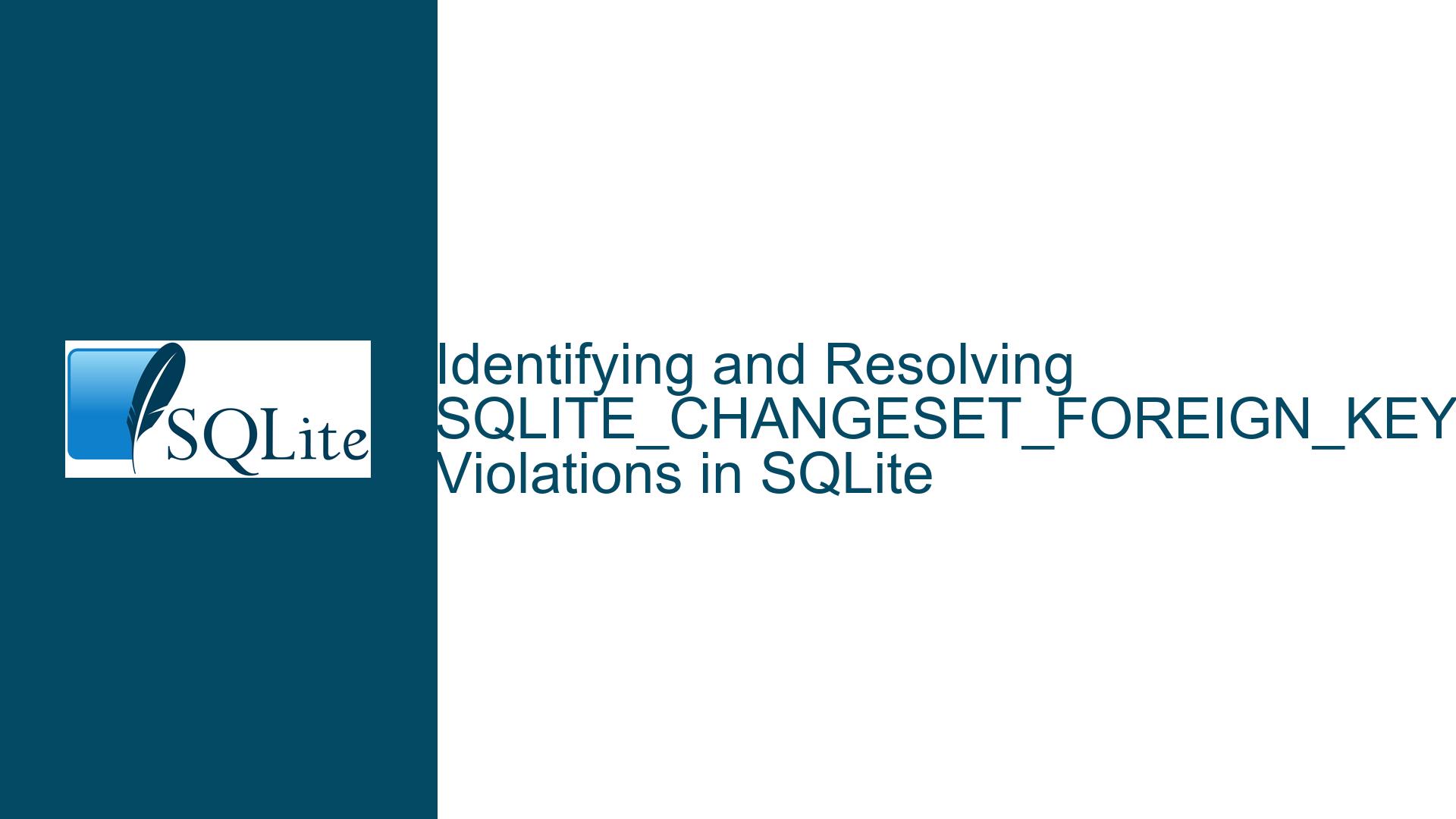Identifying and Resolving SQLITE_CHANGESET_FOREIGN_KEY Violations in SQLite
Issue Overview: Foreign Key Constraint Violations During Changeset Application
When applying changesets in SQLite using the session extension, a common challenge arises when attempting to insert or update records in a child table that references a parent table via a foreign key constraint. If a record in the changeset references a non-existent parent record, SQLite raises a SQLITE_CHANGESET_FOREIGN_KEY constraint violation. The session extension’s conflict handler provides two options: SQLITE_CHANGESET_OMIT (skip the conflicting change) or SQLITE_CHANGESET_ABORT (abort the entire changeset). However, neither option directly identifies which specific record caused the violation. This ambiguity complicates debugging and remediation, especially in large changesets or schemas with complex foreign key relationships.
The core challenge is twofold:
- Lack of Direct Identification: The conflict handler does not explicitly return the offending record’s data or metadata, making it difficult to isolate the problematic entry programmatically.
- ROWID Limitations: While the
PRAGMA foreign_key_checkcommand identifies foreign key violations, it relies onROWIDvalues to pinpoint child records. This becomes problematic for tables declaredWITHOUT ROWID, whereROWIDis either absent or not guaranteed to be stable.
For example, consider a child table orders referencing a parent customers table. If a changeset includes an order with a customer_id that does not exist in customers, the violation occurs. The developer needs to identify this specific order to exclude it from the changeset or remediate the missing customer_id.
Possible Causes: Why Foreign Key Violations Are Hard to Diagnose
1. Session Extension’s Conflict Handling Limitations
The session extension’s xConflict callback provides minimal context during a foreign key violation. It returns:
- The conflict type (
SQLITE_CHANGESET_FOREIGN_KEY). - The table name and schema.
- A count of conflicting changes.
It does not provide:
- The primary key or column values of the violating child record.
- The specific foreign key constraint that failed (critical in schemas with multiple foreign keys).
This forces developers to infer the violating records indirectly, often through post-application checks.
2. Reliance on ROWID for Foreign Key Checks
The PRAGMA foreign_key_check output includes the ROWID of violating child records. However:
- Tables declared
WITHOUT ROWIDdo not expose aROWIDcolumn. Instead, they use the primary key as the row identifier, butforeign_key_checkmay returnNULLfor such tables. - Even in tables with
ROWID, this value is not necessarily stable across schema changes or vacuums, complicating long-term tracking.
3. Composite Foreign Keys and Ambiguity
When foreign keys involve multiple columns (e.g., (country_id, city_id)), identifying violations requires matching all columns. The foreign_key_check pragma does not explicitly list the violating column values, making it necessary to reconstruct the logic manually.
4. Asynchronous Constraint Validation
Foreign key violations are checked after all changes in the changeset are tentatively applied. This differs from immediate constraint checks during normal INSERT/UPDATE operations. As a result, violations may arise from the cumulative effect of multiple changes, not just a single offending record.
Troubleshooting Steps, Solutions & Fixes
Step 1: Use PRAGMA foreign_key_check with ROWID-Based Tables
For tables that include a ROWID (the default), the foreign_key_check pragma can directly identify violating records.
Example Query:
SELECT fkc.table AS child_table,
fkc.rowid AS violating_rowid,
fkc.parent AS parent_table
FROM pragma_foreign_key_check() fkc;
This returns the ROWID of violating child records. To retrieve the full record:
SELECT * FROM child_table WHERE rowid = [violating_rowid];
Limitation: This fails for WITHOUT ROWID tables, as rowid is NULL.
Step 2: Handle WITHOUT ROWID Tables Using Primary Keys
For tables declared WITHOUT ROWID, use the primary key to join with pragma_foreign_key_check.
Example Schema:
CREATE TABLE parent (
pk TEXT PRIMARY KEY
) WITHOUT ROWID;
CREATE TABLE child (
pk TEXT PRIMARY KEY,
fk TEXT REFERENCES parent(pk)
) WITHOUT ROWID;
Violation Identification:
- Use
pragma_foreign_key_checkto get the child table and foreign key ID. - Join with the child table using its primary key.
Query:
SELECT fkc.table AS child_table,
(SELECT group_concat(fkl.from)
FROM pragma_foreign_key_list(fkc.table) fkl
WHERE fkl.id = fkc.fkid) AS fk_columns,
child.*
FROM pragma_foreign_key_check() fkc
JOIN child ON child.pk = fkc.rowid; -- Use primary key instead of ROWID
Explanation:
pragma_foreign_key_list(fkc.table)retrieves the foreign key columns for the child table.- The
JOINuses the primary key (child.pk) sincerowidis unavailable.
Step 3: Identify Orphaned Child Records with EXCEPT Queries
For schemas where joining on ROWID or primary keys is impractical, use set operations to find orphaned child records.
Example:
-- Find child records with no corresponding parent
SELECT child.fk_column
FROM child
WHERE NOT EXISTS (
SELECT 1 FROM parent WHERE parent.pk = child.fk_column
);
Composite Key Variation:
SELECT child.col1, child.col2
FROM child
WHERE NOT EXISTS (
SELECT 1 FROM parent
WHERE parent.col1 = child.col1 AND parent.col2 = child.col2
);
Advantage: This approach works regardless of ROWID configuration.
Step 4: Automate Violation Detection with Dynamic SQL
For complex schemas with multiple foreign keys, automate the generation of violation-checking queries.
Example Script:
-- Create a view to generate violation-checking SQL
CREATE VIEW find_orphans AS
WITH violated_fks AS (
SELECT table AS child_table,
parent AS parent_table,
fkid
FROM pragma_foreign_key_check()
GROUP BY 1, 2, 3
)
SELECT
printf('SELECT * FROM %s WHERE NOT EXISTS (SELECT 1 FROM %s WHERE %s)',
vf.child_table,
vf.parent_table,
(SELECT group_concat(vf.child_table || '.' || fkl.from || ' = ' ||
vf.parent_table || '.' || fkl.to, ' AND ')
FROM pragma_foreign_key_list(vf.child_table) fkl
WHERE fkl.id = vf.fkid)
) AS sql_query
FROM violated_fks vf;
Usage:
-- Execute generated queries
SELECT sql_query FROM find_orphans;
Output:
SELECT * FROM child WHERE NOT EXISTS (SELECT 1 FROM parent WHERE child.fk = parent.pk);
Step 5: Leverage the Session Extension’s xConflict Callback for Logging
While the xConflict callback does not provide the violating record’s data, you can log the conflict context for post-processing.
Example Workflow:
- Configure the conflict handler to
SQLITE_CHANGESET_ABORTand log the table name, constraint type, and timestamp. - After abortion, run
foreign_key_checkto identify violations introduced by the partial changeset. - Roll back the transaction and reapply the changeset, excluding the violating records.
Pseudocode:
int xConflict(
void *pCtx,
int eConflict,
sqlite3_changeset_iter *pIter
) {
if (eConflict == SQLITE_CHANGESET_FOREIGN_KEY) {
const char *table;
sqlite3changeset_iter_table(pIter, &table);
log("Foreign key violation in table: %s", table);
}
return SQLITE_CHANGESET_ABORT;
}
Step 6: Use the eval() Extension for Automated Cleanup
For advanced users, SQLite’s eval() extension (not built by default) can dynamically execute generated cleanup SQL.
Example:
SELECT eval(printf(
'DELETE FROM %s WHERE %s;',
fkc.table,
(SELECT group_concat(fkl.from || ' = ' || quote(fkl.to), ' AND ')
FROM pragma_foreign_key_list(fkc.table) fkl
WHERE fkl.id = fkc.fkid)
))
FROM pragma_foreign_key_check() fkc;
Explanation:
- Generates a
DELETEstatement for each violating record. quote()ensures proper string escaping.
Step 7: Prevent Violations with Pre-Application Validation
Validate the changeset against the target database before applying it.
Approach:
- Create a temporary clone of the target database.
- Apply the changeset to the clone.
- Run
PRAGMA foreign_key_checkon the clone. - If violations exist, extract the offending records from the changeset.
Tools:
- Use
sqlite3_blob_opento inspect changeset contents. - Leverage the
changeset_applyfunction with a dummy conflict handler to dry-run the application.
Step 8: Schema Design Best Practices
- Avoid
WITHOUT ROWIDUnless Necessary: WhileWITHOUT ROWIDimproves performance for certain workloads, it complicates foreign key violation debugging. Use it only when benchmarks justify it. - Use Explicit Primary Keys: Always define primary keys for child tables, even if they are composite. This simplifies joins during violation checks.
- Index Foreign Key Columns: Indexing foreign key columns speeds up
EXCEPTandNOT EXISTSqueries.
Final Solution Summary
To reliably identify records causing SQLITE_CHANGESET_FOREIGN_KEY violations:
- For
ROWIDtables, usePRAGMA foreign_key_checkwithROWIDjoins. - For
WITHOUT ROWIDtables, use primary key joins orEXCEPTqueries. - Automate violation detection with dynamic SQL generation.
- Validate changesets in a cloned database before applying them.
By combining these techniques, developers can isolate violating records, skip them in changesets, and maintain referential integrity without aborting entire transactions.






